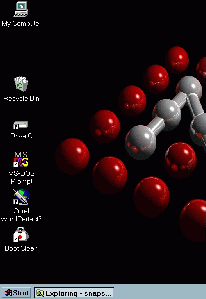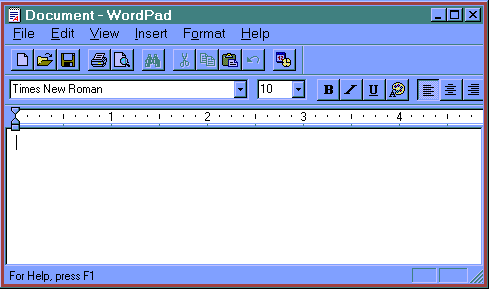
In today's lab you will be introduced to the personal computer that you will use through the remainder of the semester. Today you will learn the following:
If your computer is turned off, power it on.
The running computer should display a desktop similar to the following picture:

At the bottom of the screen is the taskbar. It contains the Start button, which can be used to quickly start a program or find a file.
Select the Start button with the left mouse button and you will see a menu that takes you to various programs you can run by selecting them with your left mouse button.
Move your mouse so that the cursor (the small arrow on the screen) moves up and down the selection of programs on the Start button menu. Notice that when you move the cursor to a menu selection with a right arrow, a sub-menu is displayed showing you more even more selections.
We will now start a program using the Start button menu. The program that we will run is called WordPad. We will start it by selecting (clicking with the left mouse button) the program name from the Start button menu. To find the program named WordPad:
This will cause the WordPad program, or application, to start running. Each running program in Windows95 has its own window.
Observe the window for the WordPad application.

At the top of the window is the titlebar which shows the name of the
application that is running. On the right side of the titlebar are three
control buttons: ![]() These buttons control the window. The right most button, the
button with a large "X", stops the application from running and closes the
window. The middle button is used to resize the window, and the left-most
button is used to minimize the window, that is, suspend the application and
place it on the task bar where it can be restarted later. Select each of
these three buttons on the WordPad window starting with the
left-most button.
These buttons control the window. The right most button, the
button with a large "X", stops the application from running and closes the
window. The middle button is used to resize the window, and the left-most
button is used to minimize the window, that is, suspend the application and
place it on the task bar where it can be restarted later. Select each of
these three buttons on the WordPad window starting with the
left-most button.
After you have selected the left-most button you will notice that the window disappears and the program name shows only on the taskbar. To reopen the window, select the program name from the taskbar.
Notice that you can enlarge and reduce the size of the window by repeatedly selecting the middle button.
When you select the right-most button, the application will terminate and the window will close. You must restart the application from the Start button menu as described above; please do that now.
The last thing that we'll do in this section is look at other ways to change the size of a window. Once you have restarted the WordPad window, move the cursor to the right corner of the window. When the cursor is placed on the corner of the window, it changes shape to become a double-headed arrow. When the cursor has the shape of a double-headed arrow, depress the left mouse button and hold it down while moving the mouse, this is called dragging. You can change the size of the window by dragging any of the corners; try that now. Notice that you can also move the window in the desktop environment by dragging the titlebar; try that now.
In this section, we will learn to use Netscape to access the Internet. As part of this section, you will find this lab on the Internet.
Begin by starting the Netscape program, you will find it by following the following chain of selections:
When Netscape first starts running, it displays the contents of the UNCA home page. This is the file located at the Internet address http://www.unca.edu/. That is the address shown in the location text window near the top of the Netscape window.
Your first task is to change the file that is displayed in the Netscape window. To do this, select the open button which is located in the toolbar near the top of the Netscape window. When you select that button, a small text window will appear and you should enter the URL, Universal Resource Locator, of the information you wish to display. The URL is as follows:
This URL is the 107 class home page. The first part of the URL "http" indicates the transfer protocol, Hypertext Transfer Protocol, used to retrieve the page. The second part, www.cs.unca.edu, is the name of the computer containing the page. The final part, classes/107/, points to a file stored on www.cs.unca.edu.
From this point on, you are expected to complete this lab, and all future labs, by following Internet pages.
The telnet protocol is used to connect to a remote computer over the Internet. There are many programs that use the telnet protocol. The one most frequently used in UNCA computer labs is called NetTerm. To start NetTerm, go through
NetTerm, like most Windows applications, has a menu bar at the top of its windows. The menu bar is a row of pulldown menus such as File and Edit. Immediately below the menu bar, you'll see a tool bar, a row of boxes containing icons. Press on the index card icon, the phone directory. When the phone directory is displayed, select the item
Next press on the phone icon to make the connection. You should now see the login prompt from bulldog.unca.edu:
Digital UNIX (bulldog.unca.edu) (ttyp4) login:
Type your bulldog user-id. (Most likely your userid is your initials followed by the first six characters of your last name.) Now you should then see the password prompt. Enter your bulldog password. Your password will not be echoed as you type it.
You will probably find yourself connected to the Bulldog Main Menu. If so, quickly type "exit" followed by the letter 'N' to stop this wimpish interface from interfering with your enjoyment of the Unix operating system.
You should now see the Unix command, or shell, prompt:
bulldog.unca.edu>
The program for reading and sending email on bulldog is called pine. Simply type the letters "pine" at the shell prompt to start the program pine.
This will bring you to pine's main command menu:
? HELP - Get help using Pine
C COMPOSE MESSAGE - Compose and send a message
I FOLDER INDEX - View messages in current folder
L FOLDER LIST - Select a folder to view
A ADDRESS BOOK - Update address book
S SETUP - Configure or update Pine
Q QUIT - Exit the Pine program
Go ahead and type C to compose, or send, a message.
You'll then see the following simple form for sending email.
To : Cc : Attchmnt: Subject : ----- Message Text -----
Fill in the To: line with the names of your CSCI 107 lab and lecture instructors, given in the table below:
| Rob Bowen | rbowen@unca.edu |
| Dean Brock | brock@cs.unca.edu |
| Charles Massey | massey@cs.unca.edu |
Then hit the enter key a couple of times to go to the Subject:line. There type some appropriate subject, such as
Hitting the enter key again takes you past the headers down into the message text area. Type a couple of paragraphs saying something about your experience with computers. You can use the arrow keys and the delete key to correct any mistakes.
When you are ready to send your message, type ^X (control-X). You should then be back at the main pine menu where you can type Q to quit pine and return to the shell prompt.
When you have the time, type ?, for HELP, to pine's first screen and read a bit more about this useful and easy-to-use program.
By now, you must be wishing for an easy way to flip between programs in Windows 95. Press the ALT and TAB keys simultaneously to bounce between telnet and Netscape.
Type the logoutcommand at bulldog's shell prompt, terminate your NetTermand Netscapeapplications, and go read chapter 1 of the textbook.
Return to CSCI 107 page
![]() Return to the UNCA Computer Science home page
Return to the UNCA Computer Science home page